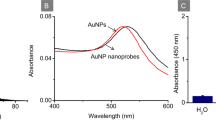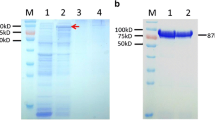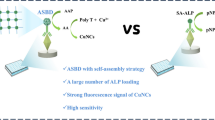Abstract
A highly sensitive transgenic protein analysis method was proposed here based on fluorescein diacetate (FDA). First, FDA was prepared by the ball mill to harvest the nano-sized organic particles. Further examines showed that the FDA size can be controlled by the speed of centrifugation which can obtain FDA in well-distributed size. Cy3 antibody immobilization tests showed that the proteins can attach onto the FDA particles while keep bioactivities. FDA and Cry1Ac antibody immunoassay tests showed that when the FDA particle was in 150 nm, the linear range was 0.01 ng/L-30 μg/mL. And it has the lower detection limitation of 0.01 ng/L, which is 100 times more sensitive than the ELISA methods. These results indicate that the FDA related immunoassays are the promising approach in the transgenic analysis.







Similar content being viewed by others
References
Goodman WG, Huang ZH, Robinson GE, Strambi C, Strambi A (1993) Comparison of two juvenile hormone radioimmunoassays. Arch Insect Biochem Physiol 23:147–152
Natalia CT, Gao Z (2006) Nanoparticles in biomolecular detection. NanoToday 1:28–37
Cao C, Shi C, Li P, Chien DY, Choo QL, Tabrizi A, Kuo C, McFarland J, Berger K, Lee C, Shuster JR, Nguyen T, Moyer DL (1996) Diagnosis of hepatitis C virus (HCV) infection by antigen-capturing ELISA. Clin Diagn Virol 6:137–145
Cock LD, Hutse V, Verhaegen E, Quoilin S, Vandenberghe H, Vranckx R (2004) Detection of HCV antibodies in oral fluid. J Virol Methods 122:179–183
Cao YC, Liu TC, Hua XF, Zhu XX, Wang HQ, Huang ZL, Zhao YD, Liu MX, Luo QM (2006) Quantum dot optical encoded polystyrene beads for DNA detection. J Biomed Opt 11:e054025
Hua XF, Liu TC, Cao YC, Liu B, Wang HQ, Wang JH, Huang ZL, Zhao YD (2006) Characterization of the coupling of quantum dots and immunoglobulin antibodies. Anal Bioanal Chem 386:1665–1671
Schroter M, Zollner B, Schafer P, Laufs R, Feycht HH (2001) Comparison of three HCV genotyping assays: a serological method as a reliable and inexpensive alternative to PCR based assays. J Clin Virol 23:57–63
Cao YC, Huang ZL, Liu TC, Cao YC, Wang HQ, Zhu XX, Wang Z, Zhao YD, Liu MX, Luo QM (2006) Preparation of silica encapsulated quantum dot encoded beads for multiplex assay and its properties. Anal Biochem 351:193–200
Chan CPY, Bruemmel Y, Seydack M, Sin KK, Wong LW, Merisko LE, Trau D, Renneberg R (2004) Nanocrystal biolabels with releasable fluorophores for immunoassays. Anal Chem 76:3638–3645
Cao YC, Wang Z, Wang HQ, Wang JH, Hua XF, Jin X, Yang L, Huang ZL, Liu MX, Zhao YD (2009) Enhanced optical property of Au coated polystyrene beads for multi-color quantum dots encoding. J Nanosci Nanotechnol 9:1778–1784
Bruemmel Y, Chan CP, Renneberg R, Thuenemann A, Seydack M (2004) On the influence of different surfaces in Nano- and submicrometer particle based fluorescence immunoasays. Langmuir 20:9371–9379
Yang W, Trau D, Renneberg R, Yu NT, Caruso FJ (2001) Layer-by-layer construction of novel biofunctional fluorescent microparticles for immunoassay applications. J Colloid Interface Sci 234:356–362
Wakayama J, Sekiguchi H, Akanuma S, Ohtani T, Sugiyama S (2008) Methods for reducing nonspecific interaction in antibody–antigen assay via atomic force microscopy. Anal Biochem 380:51–58
Trau D, Yang W, Seydack M, Caruso F, Yu NT, Renneberg R (2002) Nanoencapsulated microcrystalline particles for superamplified biochemical assays. Anal Chem 74:5480–5486
Pei RJ, Cui XQ, Yang XR, Wang EK (2000) Real-time immunoassay of antibody activity in serum by surface Plasmon resonance biosensor. Talanta 53:481–488
Godfray HCJ, Beddington JR, Crute IR, Haddad L, Lawrence D, Muir JF, Toulmin C (2010) Food security: the challenge of feeding 9 billion people. Science 327:812–818
Grunert KG (2005) Food quality and safety: consumer perception and demand. Eur Rev Agric Econ 32:369–391
Konig A, Cockburn A, Crevel RWR, Debruyne E, Grafstroem R, Hammerling U, Kimber I, Knudsen I, Kuiper HA, Peijnenburg AACM, Penninks AH, Poulsen M, Schauzu M, Wal JM (2004) Assessment of the safety of foods derived from genetically modified (GM) crops. Food Chem Toxicol 42:1047–1088
Wu W, Lu H, Liu W, Devare M, Thies JE, Chen Y, Zhang X (2009) Decomposition of Bacillus thuringiensis (Bt) transgenic rice residues (straw and roots) in paddy fields. J Soils Sediments 9:457–467
Swan CM, Jensen PD, Dively GP, Lamp WO (2009) Processing of transgenic crop residues in stream ecosystems. J Appl Ecol 46:1304–1313
Wang Z, Cao YC (2014) An organic nanoparticle based high signal amplification immunoassay with improvement of nonspecific binding. J Nanomed Nanotechnol 5:207
Acknowledgments
The Project was sponsored by the Scientific Research Initial funding for the advanced talent of Janghan University (08010001, 06660001, 2011023), Hubei Province Innovative Young Research Team in Universities (T201318), Hubei Provincial Key Natural Science Foundations (2014CFA098) and National High Technology Research and Development Program of China ( 863 Program: 2015AA033406).
Author information
Authors and Affiliations
Corresponding authors
Rights and permissions
About this article
Cite this article
Liu, C., Zhou, Z., Zou, L. et al. High Sensitivity Bacillus thuringiensis Cry1Ac Protein Detections Using Fluorescein Diacetate Nanoparticles. J Fluoresc 26, 451–457 (2016). https://doi.org/10.1007/s10895-015-1731-x
Received:
Accepted:
Published:
Issue Date:
DOI: https://doi.org/10.1007/s10895-015-1731-x




